High-quality marine binoculars for sailing, yachting and boating.
The best marine binocular is an irreplaceable tool for those who are at sea and care about the safety of the vessel. Even though SOLAS doesn’t include the info about the particular number of binoculars that should be present on ships, it is essential to have high-quality optical tools at hand in case of emergency.
If you are a mariner, you should learn about the key features of the binoculars to make sure you are using the right ones or choose the new model that meets your requirements.
Those who work in the marine environment should be armed with the best binoculars for sailing. However, it might be rather challenging to choose the right model that will work for you.
We’ve carefully tested the most popular options currently available on the market to save your time and take your shopping game to the next level.

Magnification: 7x | Objective diameter: 50 mm | Field of view at 1000m: 378 ft | Closest focusing distance: 33 ft | Eye relief: 22.7 mm | Weight: 56.79 oz
⊕ Fast, easy central focusing
⊕ Perfect for those who wear glasses
⊕ Durable polycarbonate construction
⊕ Solid grip in cold or wet weather conditions
⊖ Doesn’t include compass
Nikon 7x50 OceanPro is one of the most popular models in the Nikon Marine Binocular Series. Due to the convenient central focusing and long eye relief, these nautical binoculars are a perfect option for those, who wear glasses.
Nikon 7x50 OceanPro are durable, water- and fog-resistant binoculars that are appreciated by the users for their rubber armoring and polycarbonate body. Not only mariners can use these binoculars, but they will also come in handy for birdwatching, boating and viewing distant objects.
With BaK4 high index prisms and multi-layer lens coating, you will enjoy a bright and crisp image regardless of what you prefer to look at.
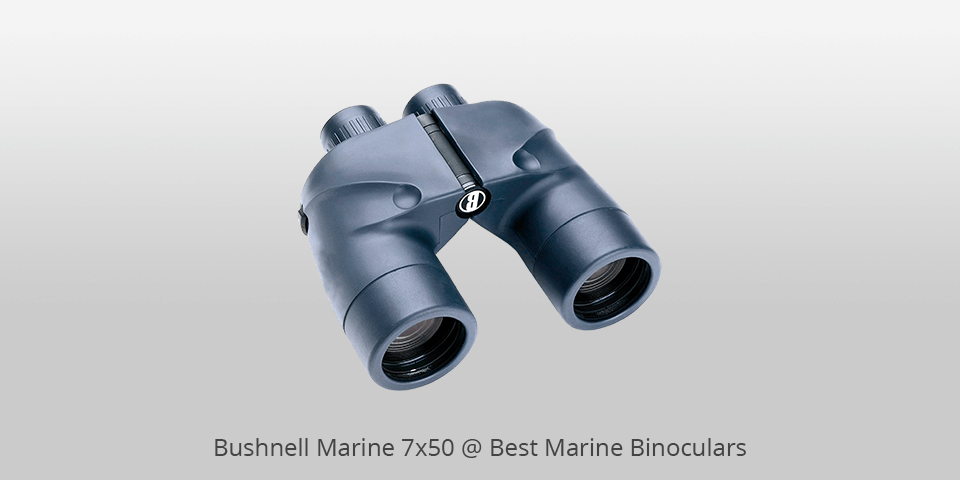
Magnification: 7x | Objective diameter: 50mm | Field of view at 1000m: 367 ft | Closest focusing distance: 35 ft | Eye relief: 18 mm | Weight: 37 oz
⊕ Durable body
⊕ Water/fog resistant
⊕ Bulky
⊖ Heavy
⊖ Large size
Even though Bushnell Marine 7x50 binoculars are rather bulky, they boast innovative technologies that make them stand out from the rivals. Bushnell is a leading brand in the modern optical market that produces only the premium-quality products.
These water-resistant binoculars have a variety of features that will come in handy for those, who are all about long-range water-specific observing. Even if you use this tool on the rough seas, it will provide a secure grip due to its heavy-duty rubber armor and non-slick surface.
Bushnell Marine 7x50 is also a popular product among sightseeing tourists.

Magnification: 7x | Objective diameter: 50mm | Field of view at 1000m: 438 ft | Closest focusing distance: 66 ft | Eye relief: 20mm | Weight: 2.62 pounds
⊕ Easy to use high-precision functionality
⊕ Water/fog resistant
⊕ First-class magnification capabilities
⊕ Built-in HD stabilized compass
⊖ Bulkier and heavier compared to similar devices
⊖ Requires time to get focused
Being easy to use, Steiner Commander 7x50C Binoculars offer a lot of features, including those that will be useful for the military. One of the most distinctive advantages of this product is the HD stabilized compass, which can be especially helpful during the hunting or hiking.
The HD compass has accurate calibration and gives precise location info. Moreover, Steiner Commander comes with a magnification of 7 and an objective lens diameter of 50 mm. With a durable Makrolon housing and water/fog resistant N2 Injection System, you can use these sea binoculars in any weather conditions.
Also, this device features Autofocus System that produces a sharp and detailed image.
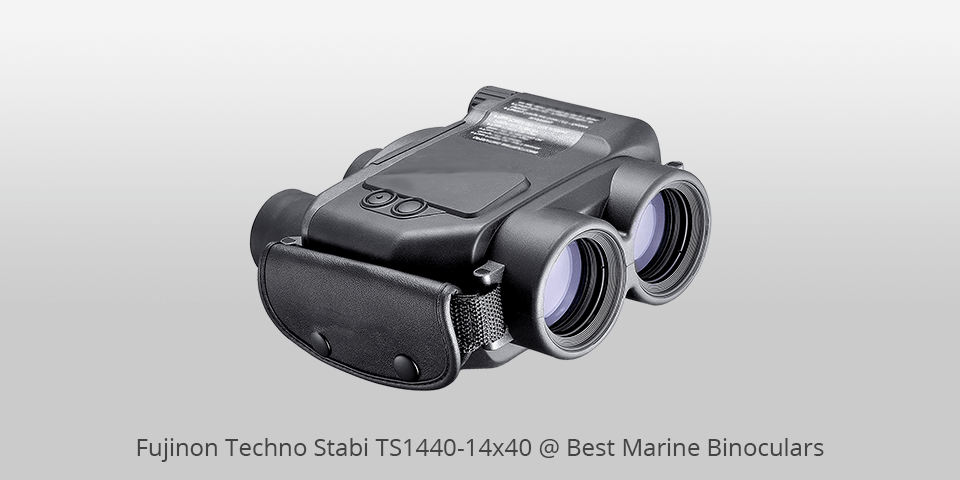
Magnification: 14x | Objective diameter: 40mm | Field of view at 1000m: 70metres | Closest focusing distance: 5metres | Eye relief: 13mm | Weight: 1300g
⊕ For stargazing and long-distance viewing
⊕ Durable watertight and fog proof body
⊕ Multi-coated lenses for clear image
⊕ Optical image stabilization
⊖ May seem difficult to use for the beginners
⊖ Loose battery case can be easily lost
Fujinon binoculars aren’t inferior to Canon ones in terms of capabilities. Moreover, Fujinon is considered to be one of the best image stabilization binoculars manufacturers on the market.
Comparing Techno Stabi TS with Canon IS, we can say that the former is an even more appealing option due to its price tag. Fujinon Techno Stabi TS1440 14×40 includes a first-class image stabilization system designed to produce a steady view at decent magnifications.
Moreover, when you activate a stabilization system, there won’t appear any noise. These features make Fujinon Techno Stabi TS1440 one of the best marine binoculars for tactical response operations and emergencies.
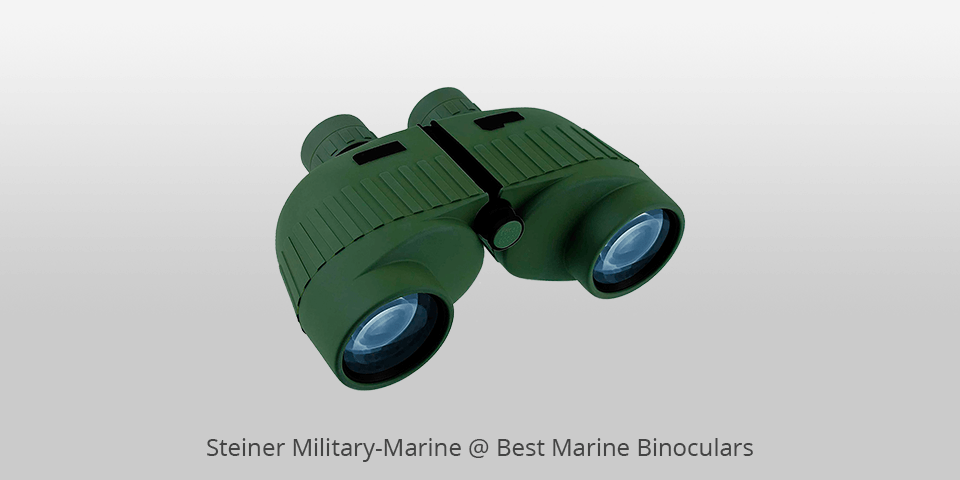
Magnification: 8 x | Objective diameter: 30mm | Field of view at 1000m: 360ft | Closest focusing distance: metres/ ft | Eye relief: 20mm
⊕ Lightweight
⊕ Compact and portable
⊕ Wide field of view
⊕ First-class autofocus
⊖ Slightly low magnification power
⊖ Doesn’t come with a tripod
Due to its fantastic set of features, these 8×30 binoculars for marine use are considered to be one of the greatest products in the industry. This device is demandable not only among those, who are rolling in a sea, but also among Safari lovers, for hunting, military and wildlife watching.
Steiner will be especially useful for those, who are all about exploring nature and wildlife.
Steiner Marine 8×30 has a durable and sturdy construction while offering a high level of compactness and portability. Also, this device is fog and waterproof.
With a pretty good magnification power and an array of settings, you can observe the objects in the most different places, whether you prefer to hike in the mountains or deep canyons.
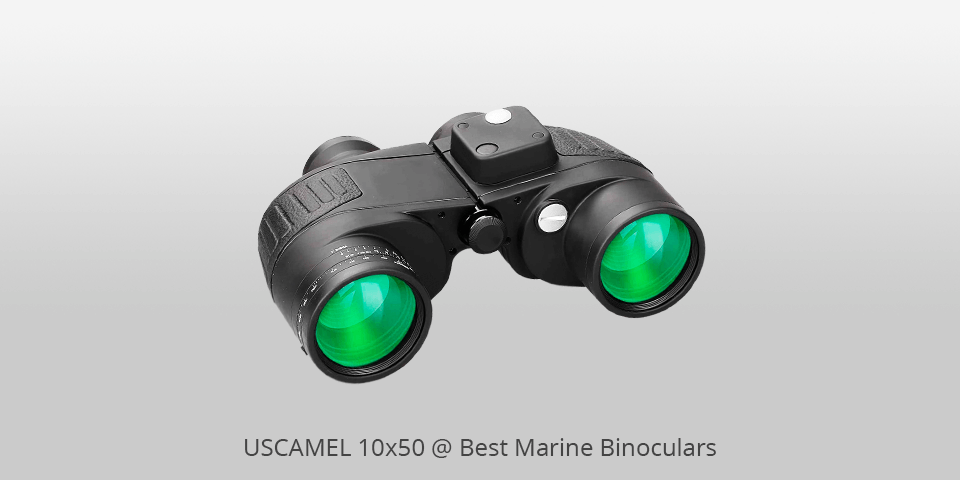
Magnification: 10x | Objective diameter: 50 mm | Field of view at 1000m: 396 ft | Closest focusing distance: metres/ ft | Eye relief: 22mm | Weight: 2.68 pounds
⊕ Excellent price
⊕ Suitable for all weather conditions
⊕ Nitrogen gas reduces fogging and mold
⊖ Difficult-to-calibrate built-in compass
⊖ Lens covers could be better
If you are on the lookout for the best boat binoculars at an affordable price, this rangefinder USCAMEL model might be the most optimal option. These binoculars are fantastic, and they will give you numerous privileges in many areas.
They are durable, tough, and can be used almost anywhere in the daytime or at night. Considering their functionality, USCAMEL 10x50 is a worthwhile option to pay attention to.
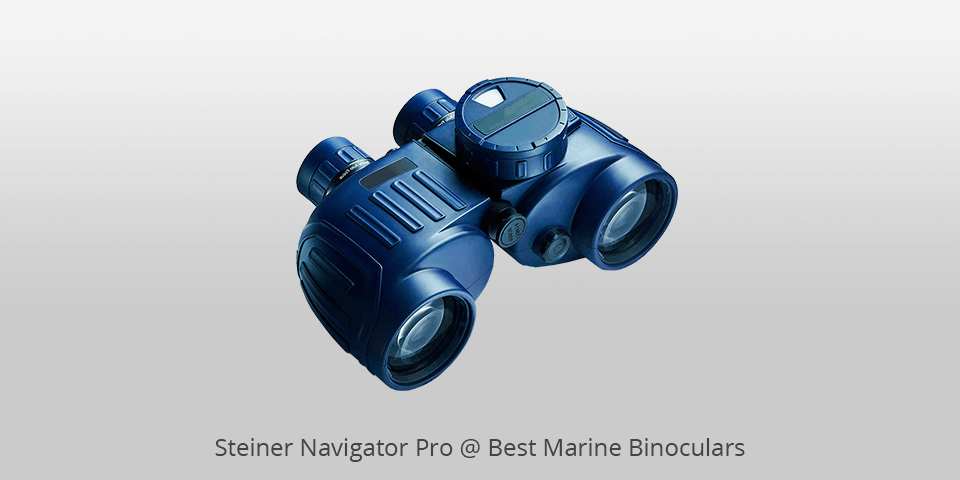
Magnification: 7x | Objective diameter: 50mm | Field of view at 1000m: 124.2 metres | Closest focusing distance: 4.2 metres| Eye relief: 20mm | Weight: 2.42 pounds
⊕ Rugged, fully sealed housing
⊕ Decent correction of chromatic aberration
⊕ Slight distortion
⊕ Moderate coma
⊖ Lacks coatings on optical prisms
⊖ Truncated exit pupils, darkened on the very edge
⊖ Poor interior of the tubes
Navigator Pro 7X50C is another decent option among sailing binoculars that is popular among boaters and hobby sailors. For this price, you will achieve a feature-rich product with premium performance.
Even though this model isn’t suitable for military purposes, it will be a perfect fit for marine enthusiasts. Navigator Pro 7X50C comes with HD fluid-damped illuminated analog compass and a maximum magnification of seven to identify distant objects quickly. With 36.3oz weight, 8.1" width, and 5.5" height, this model delivers a convenient grip for any hand.
| Image | Name | Features | |
|---|---|---|---|
 |
Nikon 16026
Our Choice |
CHECK PRICE→ | |
 |
Bushnell Marine 7x50
Professional |
CHECK PRICE → | |
 |
Steiner Marine Commander Series
Budget |
CHECK PRICE → |
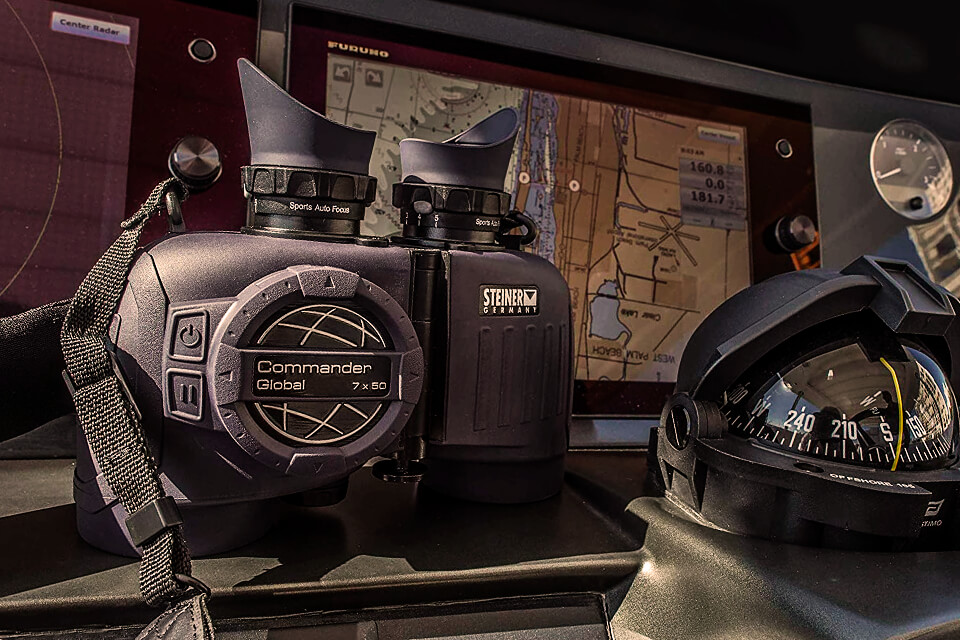
Binoculars are an essential tool at sea. Below, you will find the most important info you need to know before making a purchase.
Not so long ago, I was examining the old photos of warships. The pictures of battleships launching shells the size of cars on top of each other weren’t interesting for me. Instead, I was in search of emaciated, unshaven men after several weeks at sea or beaming and happy people after the battle. And what amazed me the most in those old black and white images is that you could easily identify the captain with a pair of binoculars hanging around his neck.
A few years ago, when radar and thermal imaging were primitively developed, the Mark One Eyeball (unaided eyesight) was important. However, with the advent of technologies, the Mk1 has been considerably improved. With so numerous options on offer, picking the best marine binoculars may seem a real challenge.
The classification of binoculars is based on two numbers, for example, 8x30. The first number determines the magnification power. Thus, such binoculars will magnify an object eight times.
However, the bigger magnification doesn’t always mean effective. The 40x “observation scope” with a steady tripod mount is great for scanning the terrestrial objects, but you will never stabilize it enough at sea. If you need a portable optical tool, it is better to pick the optics with the magnification power no more than 8x.
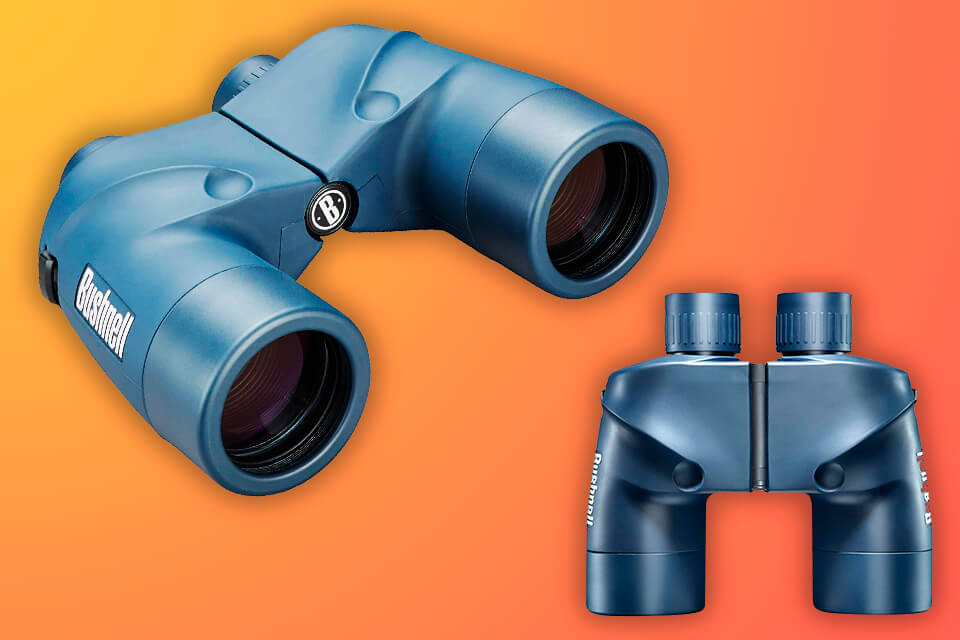
The second number determines the diameter of the objective lenses in millimeters. The large aperture of the objective lens, the more light can go through it. This is why 7×50 binoculars have twice the light gathering capabilities if compared with 7×35 ones.
7x50 binoculars produce a 7mm pupil diameter of the human eye, which is the maximum you can use. 10x50 binoculars provide a 5mm exit pupil, which is more beneficial in terms of the brightness of the image. However, the small exit pupil means your eye will be closer to the eyepiece, making such binoculars difficult to use for some people.
If you don’t have a specific purpose but want to pick binoculars for general use, something between 7x-10x magnification will be an excellent choice. Regardless of which outdoor activity you are engaged in, it will be enough for you to magnify the objects. Moreover, this magnification range will allow you to get your device steady enough, even in shaky conditions.
Be ready to pay no less than $100 to buy a good pair of optics.
Typically, the price tag of decent binoculars ranges from $100 to $500. Such world-known brands as Zeiss, Swarovski, and Nikon are more expensive. The price for high-end optics for professional use can reach up to $3000.

 Rating
Rating